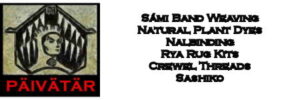One type of silk that is available is a “mawata” or silk cap. Mawata caps are formed by stretching the silk cocoons over molds. Each cap weighs about 1/2 ounce. About 25 cocoons are stretched on the mold and then sold as a “bell”.
If you purchase a bell, separate the number of caps that you need for a particular project. Silk caps dye very easily, however they must be thoroughly wet before the silk can absorb the dye. Soak the caps in water for several hours.

I used a CIBA acid based dye for wool yarn and other protein-based fibers. Gaywool dyes will also work well for this project. After the caps were thoroughly wet, I dotted small amounts of the dry dye substance – magenta and cyan onto some of the caps. With the other caps, I used Worker Red and Polar (yellow). I had two dye baths going with hot water and a bit of vinegar. I placed the caps into the water and let them cook for about 20 minutes. In the dye bath, the colours blended with each other giving wonderful ranges of purples and oranges, respectively.
I rinsed the excess dye out in cold water and then hung the caps up to dry.
Silk is a very strong fiber. If you are not careful with handling, your fingers can be cut quite easily. I use surgical gloves when I am spinning or trying to work the fibers apart.
The cap can be pulled apart and a thin roving can be drafted from it. Pull the cap apart into thin layers. Then pull it slowly apart working a small hole into the centre of the cap and stretch it into a doughnut shape. Place this doughnut onto an umbrella swift (you probably won’t be able to open the umbrella out much).
Then try to find a loose thread on the edge of the cap that you can begin to draft from. The strands of silk fiber will start to unravel. This will take quite a bit of pulling and stretching. Sometimes the strands will be quite thin and sometimes thicker. Try to even out the consistency somewhat. I find that used toilet paper rolls are handy for winding the silk onto.
When the silk is wound into the roving, it can then be spun into silk yarn. The silk roving can be woven into fabric or used as is, but I have found that giving it a slight twist with the spinning wheel makes the fiber easier to handle when it is wound onto the bobbin for weaving.
I used the silk to weave some silk wallets.
Handspinning Books
The Fleece and Fiber Sourcebook: More Than 200 Fibers, from Animal to Spun Yarn
The Whole Craft of Spinning: From the Raw Material to the Finished Yarn
The Practical Spinner’s Guide – Cotton, Flax, Hemp (Practical Spinner’s Guides)
Spin Flax & Cotton: Traditional Techniques with Norman Kennedy
The Alden Amos Big Book of Handspinning: Being A Compendium of Information, Advice, and Opinions On the Noble Art & Craft
The Knitter’s Book of Wool: The Ultimate Guide to Understanding, Using, and Loving this Most Fabulous Fiber
The Intentional Spinner
 LONGTHREAD MEDIA VIDEO
LONGTHREAD MEDIA VIDEO
 LONGTHREAD MEDIA SUBSCRIPTIONS
HANDWOVEN MAGAZINE
PIECEWORK MAGAZINE
SPINOFF MAGAZINE
LEARN LONGTHREAD MEDIA
PAIVATAR HANDMADE
LONGTHREAD MEDIA SUBSCRIPTIONS
HANDWOVEN MAGAZINE
PIECEWORK MAGAZINE
SPINOFF MAGAZINE
LEARN LONGTHREAD MEDIA
PAIVATAR HANDMADE
 Paivatar on YouTube
Visit my YouTube channel for how-to craft videos.
Paivatar on YouTube
Visit my YouTube channel for how-to craft videos.
Or Please visit my Channel on Rumble for more how-to videos.
https://rumble.com/Paivatar
LIVE STREAMS - Paivatar Studio
KICK
TWITCH MAKERS&CRAFTING
YOUTUBE
Categories: HAND SPINNING, Silk


